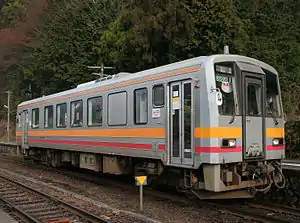KiHa 120
The KiHa 120 (キハ120形, Kiha-120-gata) is a single-car diesel multiple unit (DMU) train type operated by West Japan Railway Company (JR-West) on its rural lines in Japan. Based on Niigata Tekkō's "NDC" lightweight diesel car design intended for third sector operators (such as Matsuura Railway, Takachiho Railway, and Kumagawa Railway), a total of 89 cars were built, with the class divided into three sub-classes: KiHa 120-0, KiHa 120-200, and KiHa 120-300.[1]
| KiHa 120 | |
|---|---|
 Okayama-based KiHa 120-300 on the Inbi Line in April 2009 | |
| Manufacturer | JR-West (Gotō Works), Niigata Tekko |
| Constructed | 1991–1996 |
| Entered service | March 1992 |
| Refurbished | 2017- |
| Number built | 89 vehicles |
| Number in service | 88 vehicles |
| Number scrapped | 1 vehicle (KiHa 120-358, accident damage) |
| Formation | Single car unit |
| Operator(s) | JR-West |
| Depot(s) | Fukui, Hamada, Hiroshima, Kameyama, Kisuki, Okayama, Shimonoseki, Toyama |
| Line(s) served | Various |
| Specifications | |
| Car body construction | Steel (KiHa 120-200) Stainless steel (KiHa 120-0/300) |
| Car length | 16,300 mm (53 ft 6 in) |
| Width | 2,998 mm (9 ft 10.0 in) (KiHa 120-200) 3,188 mm (10 ft 5.5 in) (KiHa 120-0/300) |
| Doors | 2 folding doors per side |
| Maximum speed | 95 km/h (59 mph) |
| Weight | 26.9 t (KiHa 120-0) 25.9 t (KiHa 120-200) 27.7 t (KiHa 120-300) |
| Prime mover(s) | SA6D125H-1 |
| Power output | 250 hp (at 2,000 rpm) (KiHa 120-200) 330 hp (at 2,000 rpm) (KiHa 120-0/300) |
| Transmission | Hydraulic |
| Bogies | WDT53 (driving), WT237 (trailing) |
| Braking system(s) | Engine brake, Air brake |
| Safety system(s) | ATS-SW |
| Track gauge | 1,067 mm (3 ft 6 in) |
Variants
KiHa 120-200
Eight first-batch cars were built in 1992. These had painted steel bodies, two-pane windows, transverse and longitudinal seating, and no toilets. All cars were later modified with the addition of toilets.[1]
 Interior view of KiHa 120-208 in March 2007
Interior view of KiHa 120-208 in March 2007
KiHa 120-0
22 second-batch cars were built in 1993, including three cars built at JR-West's Gotō Works. These had uprated engines, stainless steel bodies, single-pane windows, longitudinal seating, and no toilets. All cars were later modified with the addition of toilets.[1][2]
KiHa 120-300
59 third-batch cars were built between 1994 and 1996, including 19 cars built at JR-West's Gotō Works. These were similar in design to the KiHa 120-0 subclass, but were built with some transverse seating. Although not initially built with toilets, all cars were modified with the addition of toilets from 2005.[1][2]
 Interior of a refurbished car
Interior of a refurbished car
Livery variations
 Fukui-based KiHa 120-205 in original livery in April 2008
Fukui-based KiHa 120-205 in original livery in April 2008 Fukui-based KiHa 120-201 in revised livery in August 2011
Fukui-based KiHa 120-201 in revised livery in August 2011 Hamada-based KiHa 120-321 in September 2008
Hamada-based KiHa 120-321 in September 2008 Hiroshima-based KiHa 120-324 in November 2008
Hiroshima-based KiHa 120-324 in November 2008 Kameyama-based KiHa 120-303 in March 2006
Kameyama-based KiHa 120-303 in March 2006 Kameyama-based KiHa 120-301 refurbished car in May 2018
Kameyama-based KiHa 120-301 refurbished car in May 2018 Kisuki-based KiHa 120-206 in original livery in September 2007
Kisuki-based KiHa 120-206 in original livery in September 2007 Kisuki-based KiHa 120-206 in revised livery in April 2017
Kisuki-based KiHa 120-206 in revised livery in April 2017 Kisuki-based KiHa 120-5
Kisuki-based KiHa 120-5 Okayama-based KiHa 120-334 in July 2006
Okayama-based KiHa 120-334 in July 2006 Shimonoseki-based KiHa 120-332 in September 2007
Shimonoseki-based KiHa 120-332 in September 2007 Toyama-based KiHa 120-300s in August 2009
Toyama-based KiHa 120-300s in August 2009
References
- Jēāru zensharyō handobukku: Rail Magazine 2009 JR全車輌ハンドブック2009 [JR Rolling Stock Handbook 2009]. Japan: Neko Publishing. 2009. ISBN 978-4-7770-0836-0.
- Nishiwaki, Kōji (November 2010). JR各社の新世代気動車の現状 JR西日本キハ120形 [The Current Situation of JR Group Modern DMUs: JR-West KiHa 120]. Japan Railfan Magazine. Vol. 50, no. 595. Japan: Kōyūsha. pp. 100–105.